Key takeaways:
- Encouraging diverse participant voices, such as through small group discussions and real-time polling, enriches workshop dialogue and fosters confidence.
- Active listening techniques, including summarizing, recognizing non-verbal cues, and maintaining eye contact, enhance participants’ feelings of being heard and validated.
- Creating inclusive environments by adapting language and materials, and ensuring safe spaces for sharing, promotes engagement and a sense of belonging among participants.
- Measuring engagement success through qualitative feedback and observing group dynamics provides deeper insights into participant satisfaction and connection beyond numerical data.
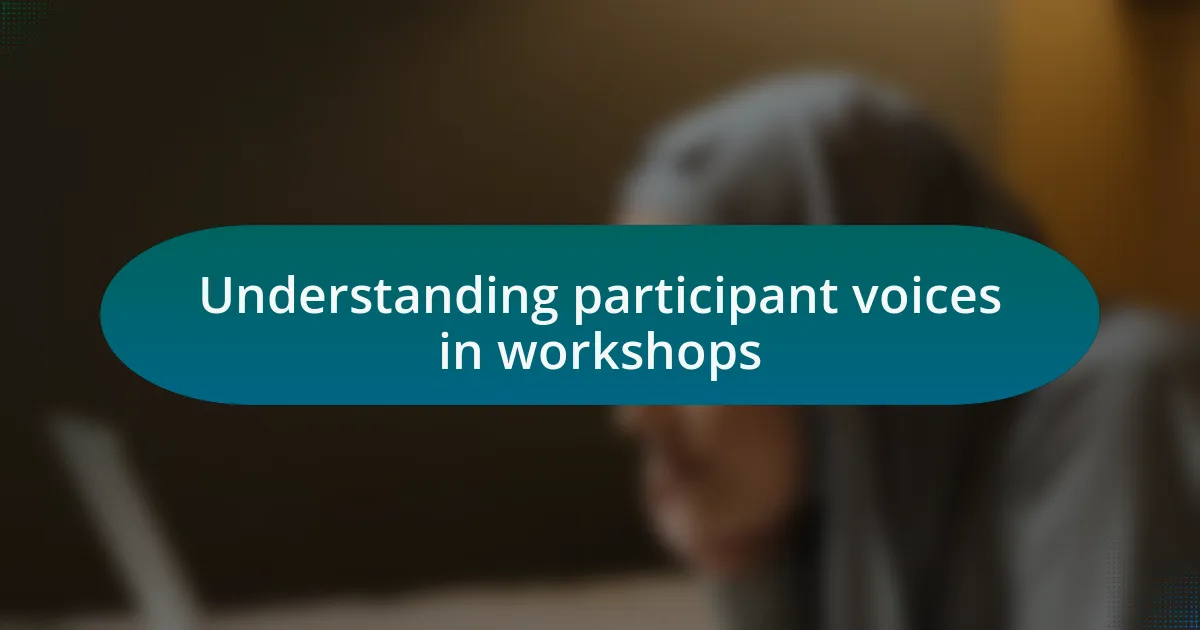
Understanding participant voices in workshops
Understanding participant voices in workshops requires us to recognize the unique stories and experiences each individual brings. I recall a particularly insightful workshop where a participant shared their struggle with imposter syndrome. This moment not only opened the floor to a deeper conversation but also made me realize how powerful personal narratives can be in fostering a supportive environment.
It’s interesting to consider how often we might overlook the diversity of voices in a workshop setting. Have you ever noticed how some participants hesitate to share their thoughts? I’ve experienced moments where silence filled the air, only for someone to break it with a profound insight that reshaped the entire discussion. This underscores the importance of actively encouraging all voices, as they contribute to a richer collective dialogue.
Listening to participant voices goes beyond just hearing words; it’s about understanding the emotions behind them. I remember a workshop where one participant expressed frustration over industry barriers. Their passion resonated with everyone, turning what could have been a mundane session into a dynamic exchange of solutions. Engaging with these voices not only validates their experiences but enriches the learning experience for all involved.
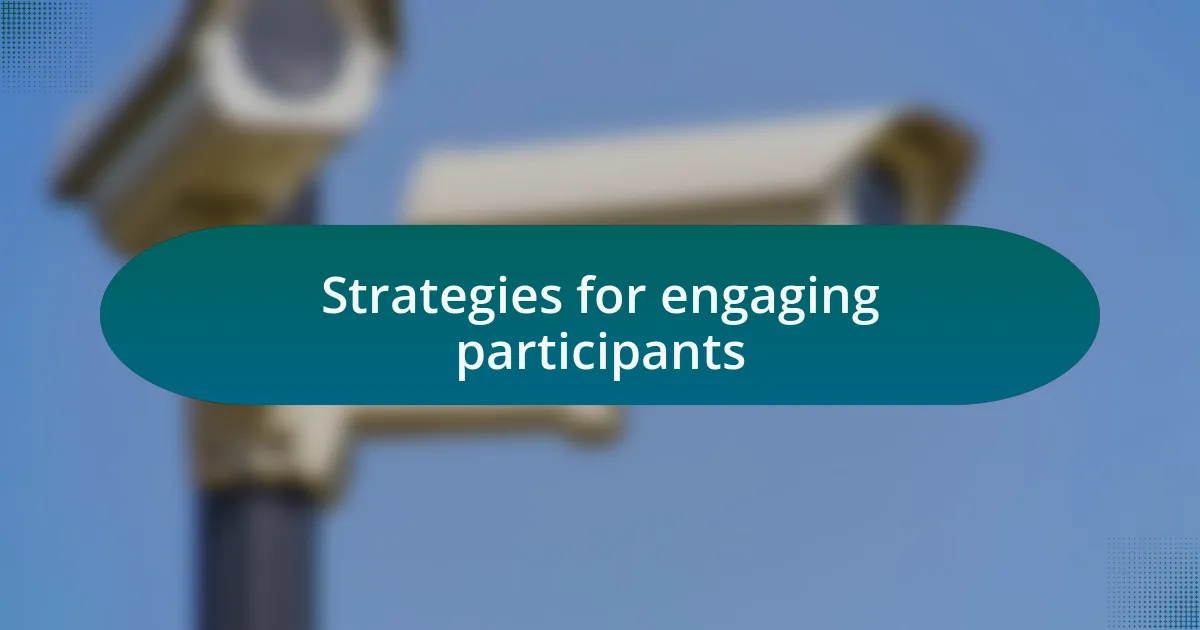
Strategies for engaging participants
One effective strategy I’ve employed is creating small group discussions. A memorable instance was when I divided participants into pairs to discuss their favorite tech innovations. The conversations were electric, and it was incredible to witness various perspectives emerge. The energy in the room shifted, and I could see participants feeling more confident as they shared their thoughts in a more intimate setting. Isn’t it fascinating how breaking down a larger group can amplify individual voices?
Another approach that has yielded great results for me is using real-time polling tools. I recall a workshop where I asked participants to vote on topics they found most pressing within the tech industry. The immediate feedback sparked lively debates and allowed me to address concerns that resonated deeply with attendees. Have you ever noticed how empowering it feels to have your opinion instantly acknowledged? It’s a simple yet powerful way to elevate participant voices and foster connection.
Lastly, including reflective moments during sessions can be incredibly engaging. After a particularly intense discussion, I often invite participants to take a minute to jot down their thoughts or feelings. During one workshop, I did this, and the insights shared afterward were enlightening. Participants expressed gratitude for the opportunity to pause and process their emotions. How do you think a brief moment of reflection could enhance your workshops? This kind of intentional pause not only helps voices rise but also deepens the collective learning experience.
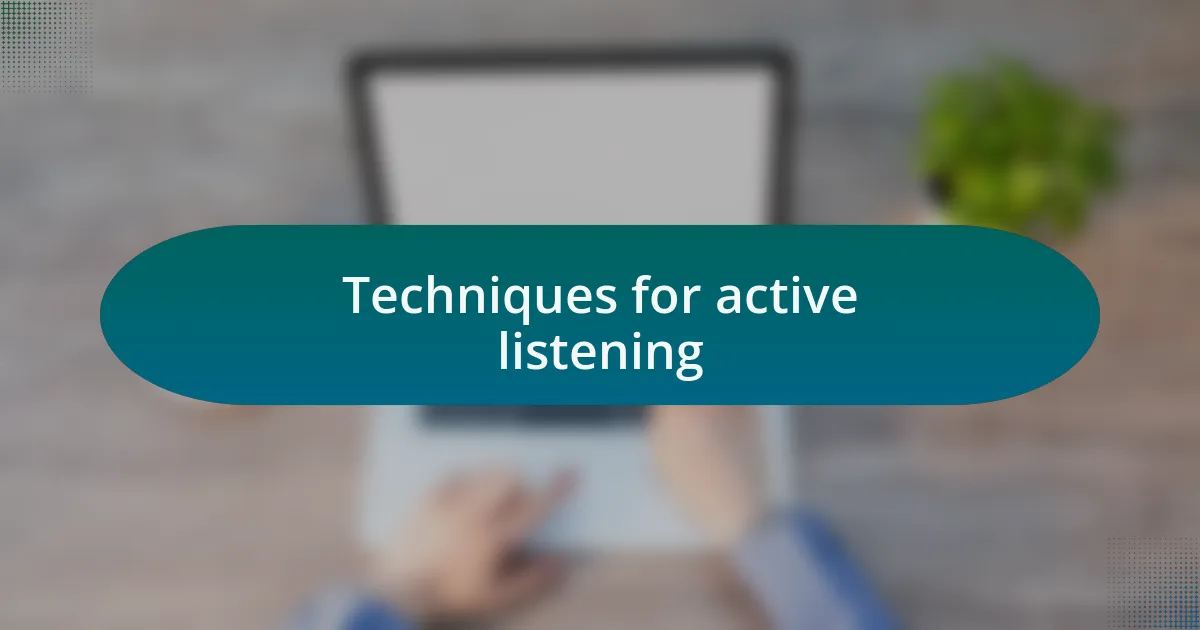
Techniques for active listening
Active listening is more than just hearing what participants say; it involves truly understanding their messages. One technique I often use is summarizing what someone has shared, then asking if I’ve captured their thoughts accurately. During a recent workshop, I made a point to reflect back a participant’s insights about automation in the tech sector, and they lit up with appreciation. Isn’t it rewarding when people feel heard and validated in a discussion?
Another effective method is paying close attention to non-verbal cues. I’ve learned that participants often communicate just as much through their body language as they do with words. For instance, I once noted a participant nodding vigorously while another spoke about the challenges of diversity in tech. Recognizing their engagement encouraged me to explore that point further. How often do we overlook these subtle signals in conversations?
Finally, I find that maintaining eye contact creates a connection that invites openness. I make a conscious effort to engage with different participants by alternating my gaze when they speak. I remember a moment when a shy attendee shared their thoughts about cybersecurity, and maintaining that visual connection helped them gain confidence. Have you ever considered how a simple gaze can empower someone to share their ideas more freely? By fostering this environment, I’ve seen participant voices flourish and become more dynamic in their contributions.
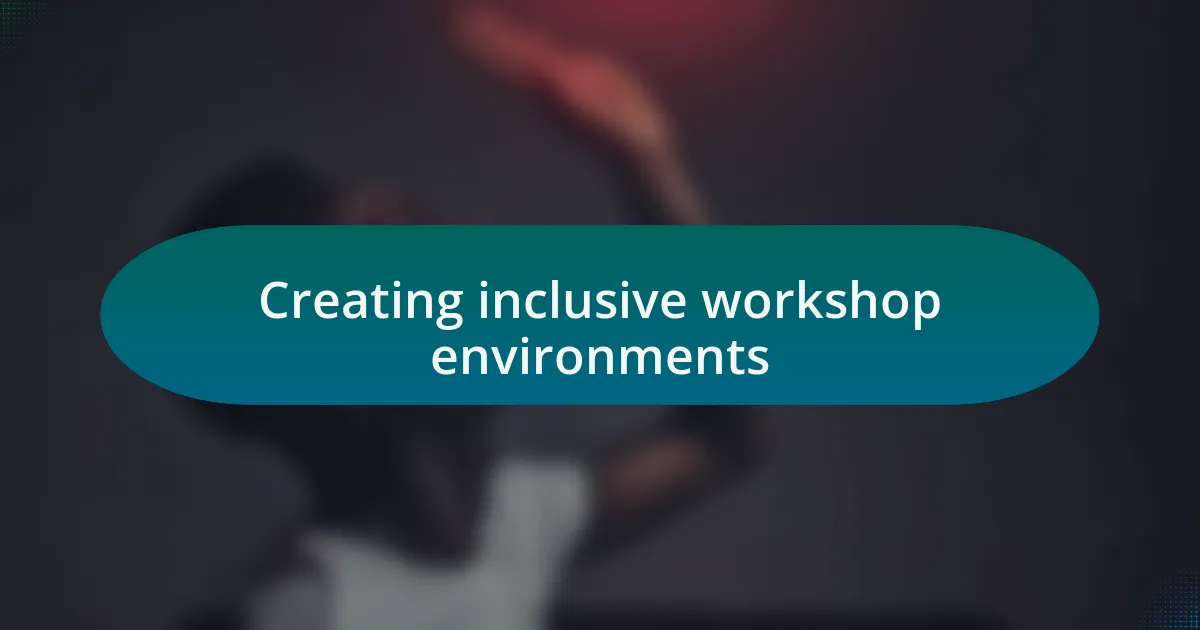
Creating inclusive workshop environments
Creating inclusive workshop environments starts with understanding the unique backgrounds and perspectives of every participant. I recall a workshop where I encouraged everyone to share their introductions, including their preferred pronouns and a personal fun fact. This simple yet heartfelt approach not only broke the ice but also fostered a sense of belonging. How powerful is it when participants feel seen and appreciated right from the start?
To further enhance inclusivity, I make it a point to adapt my language and materials to suit various learning styles. During one session, I integrated visual aids alongside verbal explanations to accommodate different preferences. I noticed that participants who typically remained quiet became more animated when they could express their thoughts through drawings or diagrams. Isn’t it fascinating how flexible approaches can unlock creativity and participation?
Lastly, I prioritize creating safe spaces where all voices are welcomed and respected. I often remind participants that all contributions, no matter how small, are valuable. In one workshop, a participant hesitated to share a critique of a popular tool. After I reassured them that constructive feedback was encouraged, they opened up, and the conversation sparked a deeper discussion on improvement. Don’t you think it’s crucial to nurture an atmosphere that invites open dialogue and fosters growth?
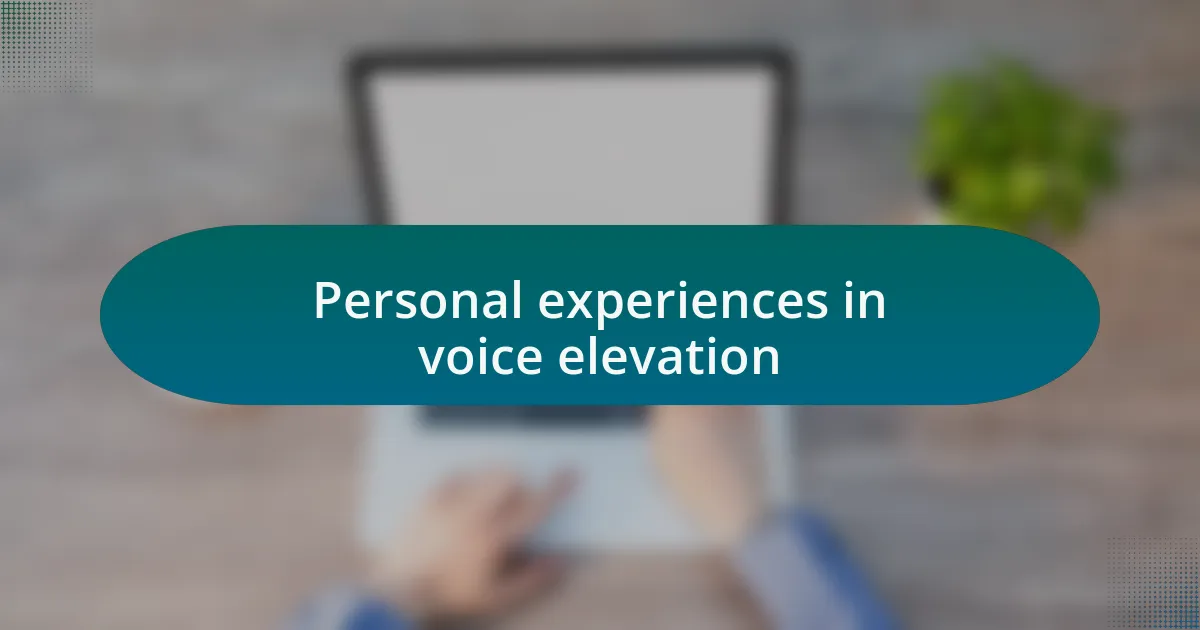
Personal experiences in voice elevation
In my own journey, I discovered the power of active listening as a tool for elevating participant voices. During a workshop on emerging technologies, I implemented small group discussions, and I made it a practice to rotate between them. I remember standing quietly in the background, listening to participants share their unique insights. It was enlightening to witness their confidence grow as they realized their thoughts mattered. Have you ever seen someone’s face light up when they felt truly heard?
Once, while co-facilitating a session on design thinking, I introduced a “voice mapping” exercise. Participants mapped out their ideas on sticky notes, and I provided time for each person to explain their contributions. I vividly recall a shy participant who initially hesitated but eventually shared a brilliant concept about user experience. The joy and surprise on their face were unforgettable, highlighting how giving space for each voice can spark innovation. Isn’t it amazing how a simple shift can ignite conversations that lead to groundbreaking ideas?
I’ve also experimented with anonymous feedback tools, which can significantly enhance participation. In one workshop, I used a digital platform for participants to submit their thoughts anonymously before we discussed them. The initial anxiety some attendees felt melted away, and I watched as they began to express opinions they wouldn’t have voiced aloud. It reinforced my belief that creating varied avenues for communication is essential to accentuating every voice. How often do we recognize that anonymity can empower participants to speak their truths more freely?
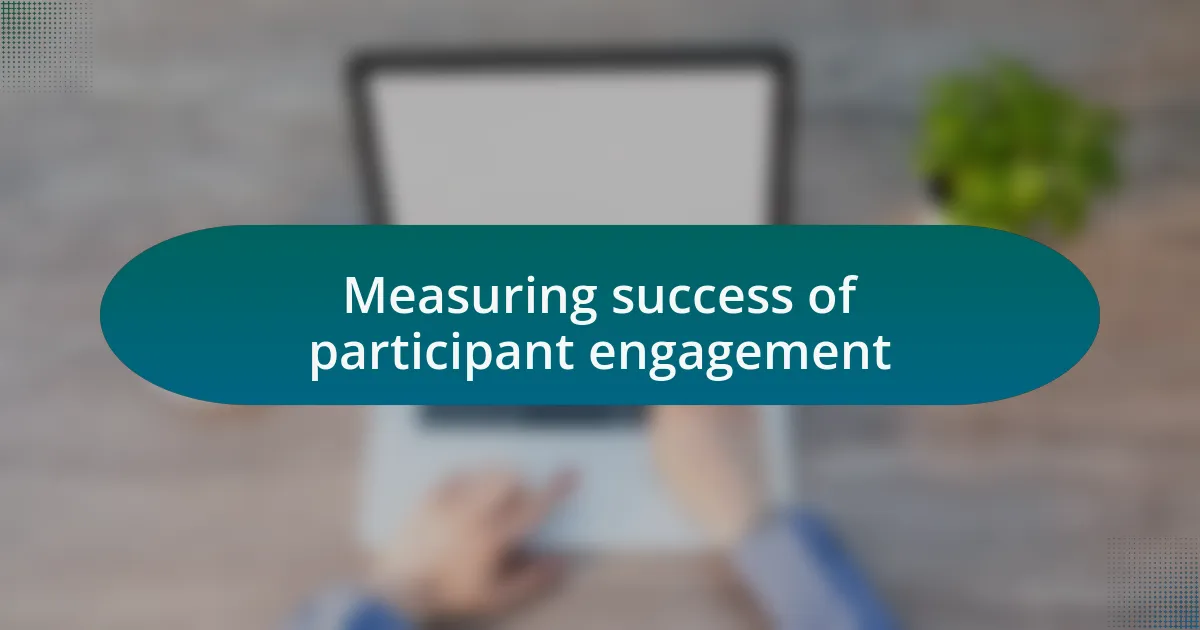
Measuring success of participant engagement
To truly measure the success of participant engagement, I often rely on qualitative feedback rather than just numerical data. For instance, in a recent workshop focused on artificial intelligence, I distributed feedback forms that included open-ended questions. It was fascinating to read the personalized comments reflecting how participants felt engaged and valued. Have you noticed how such reflections can reveal the depth of connection established during a session?
On a practical level, I also find it essential to observe group dynamics during discussions. I sometimes utilize a simple hand-raising or nodding system to gauge who feels comfortable contributing. During a discussion about cloud solutions, I noticed several participants nodding along but remaining silent. This awareness prompted me to directly invite a few of them to share their thoughts, and the resulting dialogue was rich and informative. Isn’t it interesting how the unspoken can often lead to the most profound insights?
Another effective method I’ve embraced is follow-up sessions, where I check in with participants after the workshop. In one instance, I reached out to attendees of a session on blockchain technology a month later. The responses I received illuminated how the engagement had extended beyond our meeting, with some participants collaborating on projects inspired by our conversations. It made me wonder: could follow-up be the most overlooked aspect of measuring engagement success?